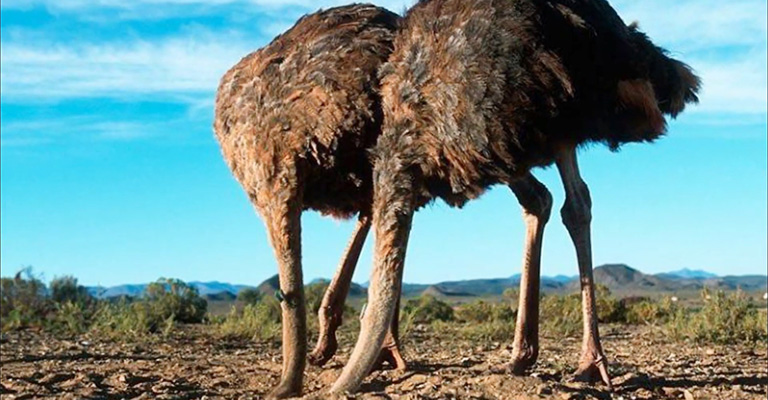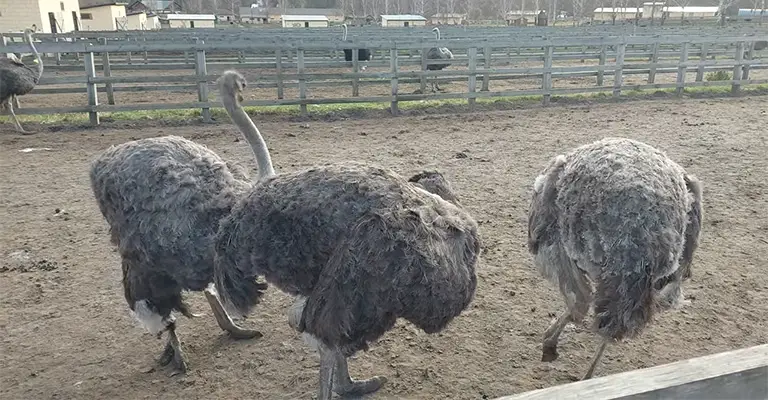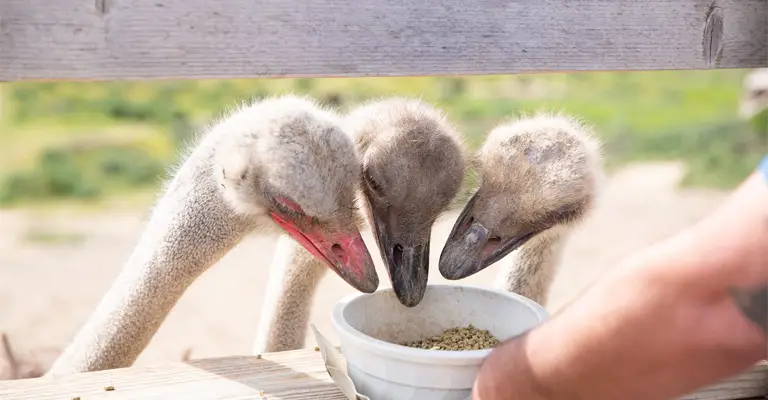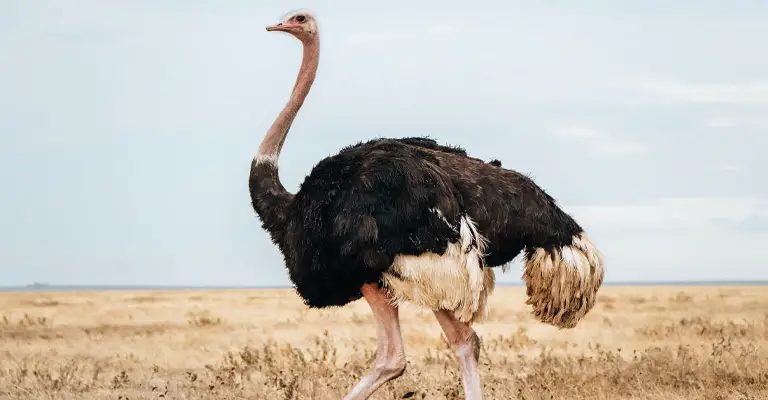The image of an ostrich burying its head in the sand has become a popular metaphor for avoiding problems or hiding from reality. But is there any truth to this notion? Ostriches are fascinating creatures known for their impressive size, speed, and unique adaptations.
However, the idea that they bury their heads in the sand as a defense mechanism is nothing more than a myth. In this article, we will delve into why do ostriches bury their heads and explore the behaviors and characteristics of ostriches that have led to this popular belief.
By understanding the truth about ostrich behavior, we can dispel the myth and gain a deeper appreciation for these remarkable birds.
So, let’s embark on a journey to uncover the truth behind why ostriches do not actually bury their heads in the sand.

Why Do Ostriches Bury Their Heads?
Ostriches do not actually bury their heads in the sand. This is a common misconception. The belief that ostriches bury their heads likely originated from the observation that ostriches sometimes lower their heads to the ground when they are threatened or alarmed.
However, they do not bury their entire heads in the sand. Here are more detailed reasons why ostriches lower their heads:
Head Positioning for Nesting
One reason why ostriches lower their heads is related to their nesting behavior. Female ostriches create shallow nests in the ground where they lay their eggs.
By lowering their heads and necks, they can blend in with the surroundings and make their nests less conspicuous to potential predators. This behavior helps protect their eggs and increases the chances of successful reproduction.
Visual Misinterpretation
Another reason for the misconception about ostriches burying their heads is the visual misinterpretation of their behavior.
When an ostrich senses danger, it may lie flat on the ground and stretch its neck out, which can give the illusion that its head is buried.
This behavior is a defense mechanism that allows the ostrich to appear less visible and avoid detection by predators.
Thermoregulation
Ostriches live in hot and arid environments, and they need to regulate their body temperature to stay cool. So, they lower their heads to the ground for thermoregulation purposes.
By pressing their heads against the cool ground, they can dissipate heat and regulate their body temperature. This behavior helps them cope with high temperatures in their natural habitats.
Camouflage
Ostriches have evolved to have a natural camouflage that helps them blend in with their surroundings. When they lower their heads, their brownish necks and heads can resemble the color of the sandy ground, making it harder for predators to spot them.
Resting Position
Ostriches may also lower their heads when they are resting or sleeping. By tucking their heads close to the ground, they can relax and conserve energy while still being alert to potential threats.
Feeding Behavior
Ostriches are herbivores and primarily feed on plants, seeds, and fruits. When foraging for food on the ground, they may lower their heads to get a closer look at the vegetation and to reach the plants more easily.
This behavior allows them to better assess their food sources and consume them efficiently.
Social Communication
Ostriches are social animals and use various body postures and movements to communicate with each other.
Lowering their heads can be a part of their social signaling. For example, a dominant ostrich may lower its head as a display of dominance or assert its authority over other members of the group.
Courtship Displays
During the breeding season, male ostriches perform elaborate courtship displays to attract females. These displays often involve lowering their heads, fluffing their feathers, and swaying from side to side.
Lowering the head can be a part of their courtship behavior to impress and attract potential mates.
Dust Bathing
Ostriches engage in dust bathing as a way to keep their feathers clean and free from parasites. They may lower their heads and roll around in the dust or sand, allowing the fine particles to penetrate their feathers.
Lowering the head during dust bathing helps them reach different parts of their body and ensures thorough cleaning.
Comfort and Relaxation
Lowering the head can also be a sign of comfort and relaxation for ostriches. When they are in a calm and content state, they may lower their heads as a way to unwind and rest.
Where Did the Myth Originate From?

The myth that ostriches bury their heads in the sand has been passed down through generations and has become a popular misconception. The origin of this myth can be traced back to a few possible sources.
Folklore and Ancient Beliefs
One possible origin of the myth lies in ancient folklore and beliefs. In ancient times, people may have observed ostriches lowering their heads and necks to blend in with their surroundings or to rest.
Over time, this observation could have been exaggerated or misunderstood, leading to the creation of the myth.
Optical Illusion and Misinterpretation
Another reason for the myth is the optical illusion created by the ostrich’s behavior. When an ostrich senses danger, it may lie flat on the ground and stretch its neck out. From a distance, this posture can give the impression that the ostrich’s head is buried in the sand.
This misinterpretation of their defensive behavior might have contributed to the belief that ostriches bury their heads.
Literary References and Artistic Depictions
The myth of ostriches burying their heads has also been perpetuated through literature and artistic depictions.
In various works of fiction, ostriches are often portrayed with their heads buried in the sand as a symbol of ignorance or avoidance.
These artistic interpretations might have further reinforced the misconception in popular culture.
Educational Misinformation
In some cases, the myth may have been perpetuated due to educational misinformation.
In the past, educational materials or books might have inaccurately described ostrich behavior, leading to the widespread belief that ostriches bury their heads in the sand.
However, with advancements in scientific knowledge and improved educational resources, the accurate understanding of ostrich behavior has become more widely known.
Why Do Ostriches Eat Sand and Pebbles?

Ostriches, like many other birds, have a unique behavior known as “ingesting grit.” While it may appear that ostriches are intentionally eating sand and pebbles, they are actually consuming these materials for a specific purpose.
Digestive Aid
Ostriches lack teeth, and their digestive system relies on mechanical grinding to break down food. By ingesting small stones, sand, and pebbles, known as grit, ostriches use them as gastroliths.
These gastroliths help to grind and crush the food they consume in their muscular gizzard, which is a specialized part of their digestive system.
The grinding action of the gastroliths helps to break down tough plant material, seeds, and other food items, making them easier to digest.
Aiding Digestion
The presence of grit in the gizzard also aids in the mechanical breakdown of food, allowing for better absorption of nutrients.
The abrasive action of the grit helps to break down food particles into smaller pieces, increasing the surface area for enzymatic digestion and facilitating the extraction of nutrients during the digestive process.
Mineral Intake
Additionally, the ingestion of grit may also provide ostriches with essential minerals. Some types of sand and pebbles contain trace minerals that can supplement their diet.
By consuming these materials, ostriches can obtain minerals like calcium, which is crucial for bone health and eggshell formation.
What Other Things Ostriches Do When Scared or Threatened?

When ostriches feel scared or threatened, they exhibit several behaviors as part of their defense mechanisms. Here are some of the actions ostriches may take when they perceive danger:
Running
Ostriches are known for their incredible running speed, reaching up to 40 miles per hour (64 kilometers per hour).
When they sense a threat, their primary response is to flee. They use their long legs and powerful strides to quickly escape from potential predators.
Wing-Flapping
Ostriches may engage in wing-flapping as a display of intimidation or to signal their readiness to defend themselves. This behavior can make them appear larger and more formidable to potential threats.
Vocalizations
Ostriches have a range of vocalizations they use to communicate with each other, including hisses, booms, and grunts. When they feel threatened, they may emit loud hissing or booming sounds to warn others or to intimidate the perceived threat.
Kicking
Ostriches have strong legs and sharp claws, which they can use as weapons when defending themselves. If cornered or provoked, they may kick out with their powerful legs, aiming to strike their attacker and deter them.
Feigning Death
In some cases, when ostriches feel extremely threatened and unable to escape, they may resort to a behavior known as “playing dead.”
They lie flat on the ground, stretch their necks out, and remain motionless, mimicking a lifeless state. This tactic aims to deceive predators into thinking they are no longer a threat.
Defensive Posture
Ostriches may adopt a defensive posture by lowering their heads, spreading their wings, and fluffing up their feathers. This display can make them appear larger and more intimidating to potential threats.
Ostriches are generally cautious and have keen senses, allowing them to detect potential dangers in their environment. Their responses to threats are primarily focused on evasion and intimidation rather than direct confrontation.
FAQs
Yes, ostriches are the fastest-running birds. They can reach speeds of up to 40 miles per hour (64 kilometers per hour), making them the fastest land bird species.
No, ostriches are flightless birds. While they have large wings, their body structure and adaptations are not suited for sustained flight. However, they have strong legs that enable them to run swiftly.
Ostriches are the largest living bird species. Adult males, known as cocks, can reach a height of around 7 to 9 feet (2.1 to 2.7 meters) and weigh up to 320 pounds (145 kilograms). Adult females, known as hens, are slightly smaller in size.
In the wild, ostriches have an average lifespan of 30 to 40 years. However, in captivity, they can live even longer, with some individuals reaching up to 50 or 60 years of age.
No, ostriches do not bury their eggs in the sand. Instead, female ostriches create shallow nests in the ground where they lay their eggs. The nests are simple scrapes in the soil, and the eggs are left exposed on the surface.
Bottom Line
The notion that ostriches bury their heads in the sand is nothing more than a myth. Ostriches are fascinating creatures with unique adaptations and behaviors that have been misunderstood over time.
By dispelling this misconception, we can appreciate the true nature of these magnificent birds. Ostriches are known for their incredible speed, size, and keen senses, which allow them to detect potential threats from afar.
Instead of burying their heads, ostriches use their powerful legs to outrun predators and rely on their excellent eyesight to assess their surroundings.
Understanding the truth about ostrich behavior not only helps us appreciate their remarkable adaptations but also reminds us to question popular beliefs and seek accurate information.
So, the next time you encounter the image of an ostrich burying its head, remember the truth behind this myth and marvel at the incredible abilities of these majestic birds.